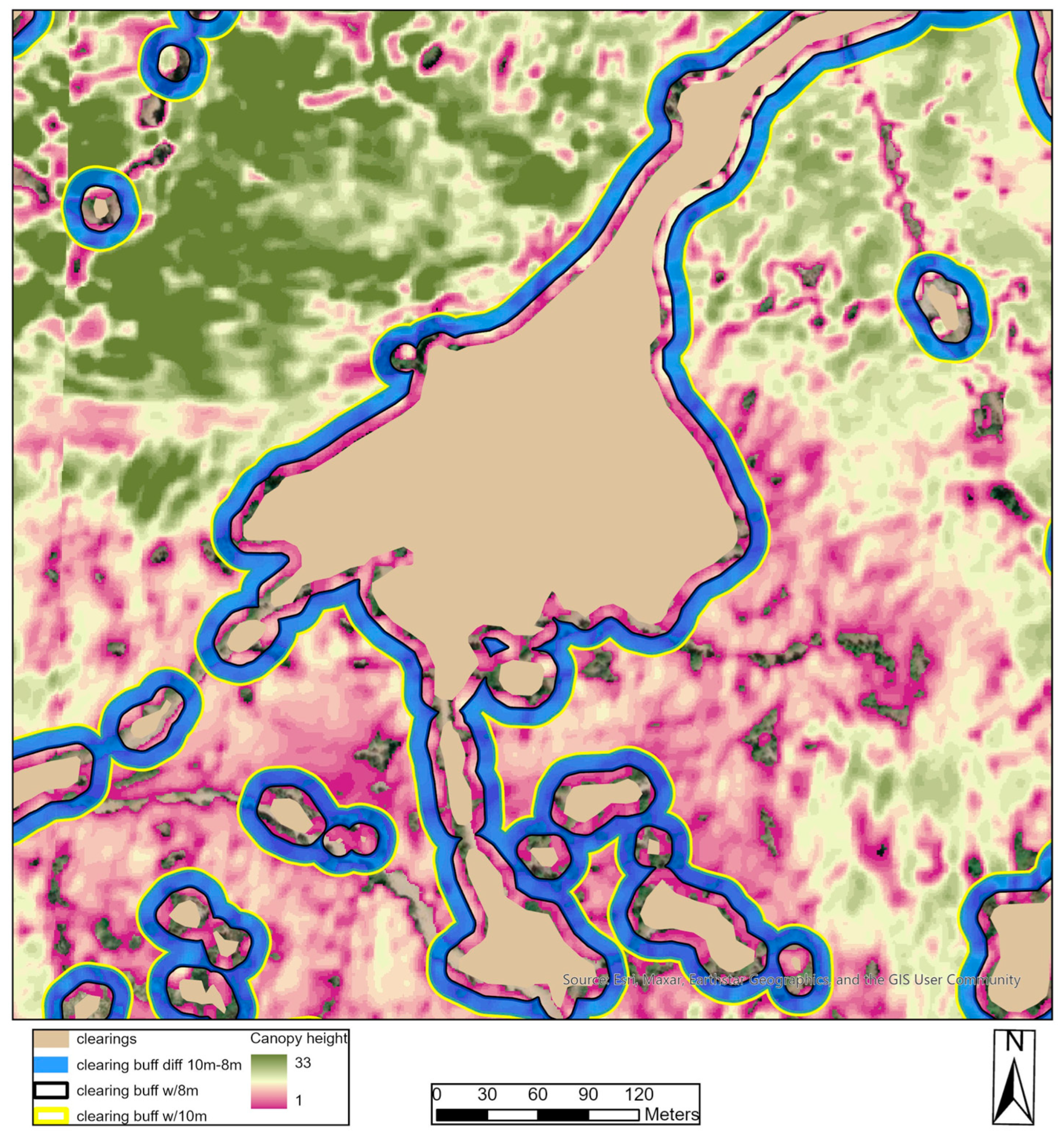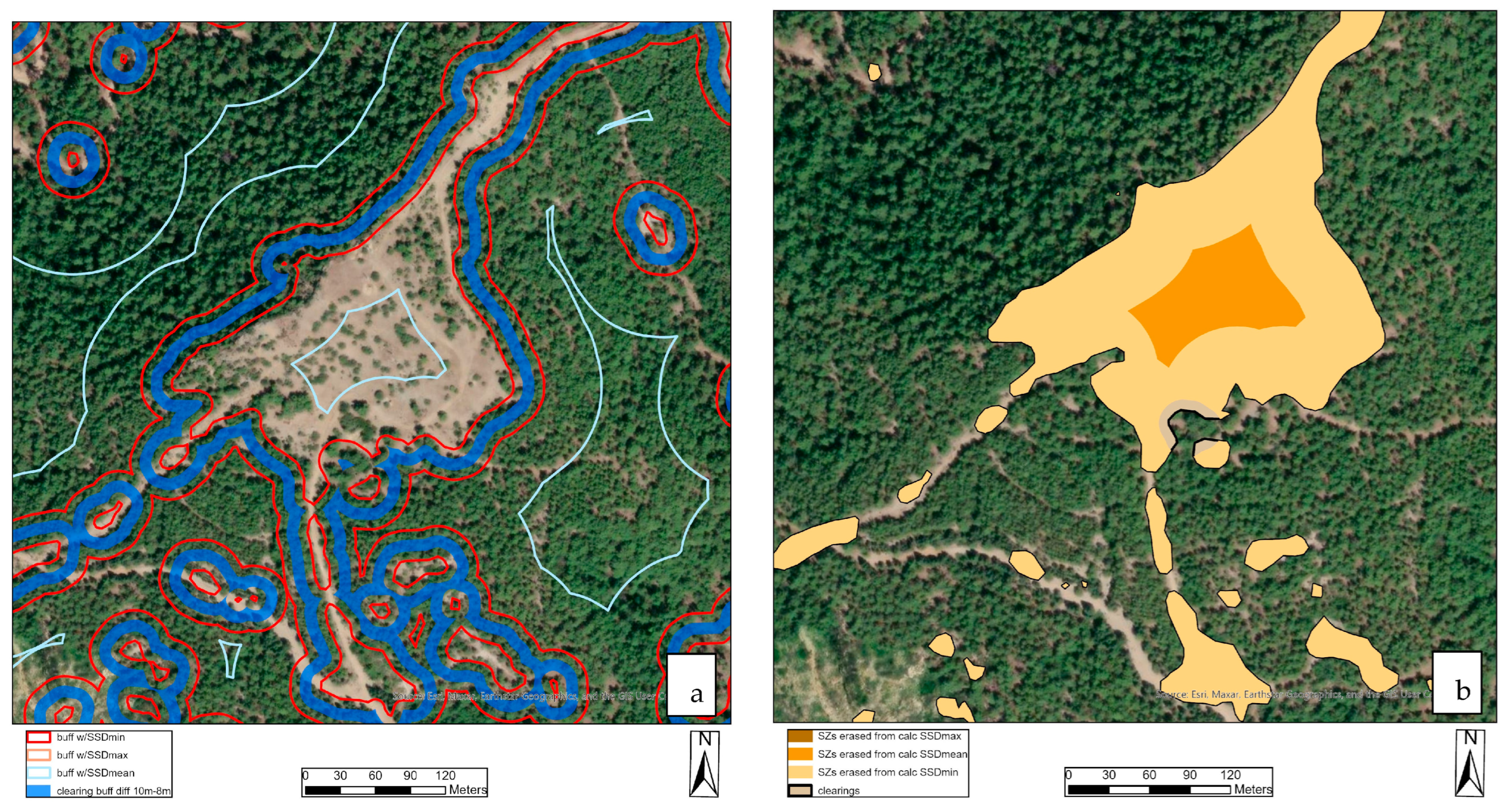Determining a Safe Distance Zone for Firefighters Using a High-Resolution Global Canopy Height Dataset—A Case in Türkiye
Abstract
:1. Introduction
2. Materials and Methods
2.1. Study Area and Data
2.2. Safety Zone Models
3. Results
4. Discussion
5. Conclusions
Funding
Data Availability Statement
Acknowledgments
Conflicts of Interest
Appendix A

References
- Campbell, M.J.; Dennison, P.E.; Thompson, M.P.; Butler, B.W. Assessing potential safety zone suitability using a new online mapping tool. Fire 2022, 5, 5. [Google Scholar] [CrossRef]
- Page, W.G.; Butler, B.W. An empirically based approach to defining wildland firefighter safety and survival zone separation distances. Int. J. Wildland Fire 2017, 26, 655–667. [Google Scholar] [CrossRef]
- Dennison, P.E.; Fryer, G.K.; Cova, T.J. Identification of firefighter safety zones using lidar. Environ. Model. Softw. 2014, 59, 91–97. [Google Scholar] [CrossRef]
- Alexander, M.E.; Taylor, S.W.; Page, W.G. Wildland firefighter safety and fire behavior prediction on the fireline. In Proceedings of the 13th International Wildland Fire Safety Summit & 4th Human Dimensions Wildland Fire Conference, Boise, ID, USA, 20–24 April 2015. [Google Scholar]
- Haynes, K.; Short, K.; Xanthopoulos, G.; Viegas, D.X.; Ribeiro, L.M.; Blanchi, R. Wildfires and WUI fire fatalities. In Encyclopedia of Wildfires and Wildland-Urban Interface (WUI) Fires; Manzello, S.L., Ed.; Springer: Cham, Switzerland, 2020; p. 16. [Google Scholar]
- Molina-Terrén, D.M.; Xanthopoulos, G.; Diakakis, M.; Ribeiro, L.; Caballero, D.; Delogu, G.M.; Viegas, D.X.; Silva, C.A.; Cardil, A. Analysis of forest fire fatalities in southern Europe: Spain, Portugal, Greece and Sardinia (Italy). Int. J. Wildland Fire 2019, 28, 85–98. [Google Scholar] [CrossRef]
- Blanchi, R.; Leonard, J.; Haynes, K.; Opie, K.; James, M.; de Oliveira, F.D. Environmental circumstances surrounding bushfire fatalities in Australia 1901–2011. Environ. Sci. Policy 2014, 37, 192–203. [Google Scholar] [CrossRef]
- Diakakis, M.; Xanthopoulos, G.; Gregos, L. Analysis of forest fire fatalities in Greece: 1977–2013. Int. J. Wildland Fire 2016, 25, 797–809. [Google Scholar] [CrossRef]
- Cardil, A.; Molina, D.M. Factors causing victims of wildland fires in Spain (1980–2010). Hum. Ecol. Risk Assess. 2015, 21, 67–80. [Google Scholar] [CrossRef]
- Alexander, M.E.; Buxton-Carr, P. Wildland fire suppression related fatalities in Canada, 1941–2010: A preliminary report. In Proceedings of the 11th International Wildland Fire Safety Summit, Missoula, MT, USA, 4–8 April 2011. [Google Scholar]
- Butler, B.W. Wildland firefighter safety zones: A review of past science and summary of future needs. Int. J. Wildland Fire 2014, 23, 295–308. [Google Scholar] [CrossRef]
- Butler, B.W.; Cohen, J.D. Firefighter safety zones: A theoretical model based on radiative heating. Int. J. Wildland Fire 1998, 8, 73–77. [Google Scholar] [CrossRef]
- Butler, B.; Parsons, R.; Mell, W. Recent findings relating to firefighter safety zones. In Proceedings of the Large Wildland Fires Conference, Missoula, MT, USA, 19–23 May 2014. [Google Scholar]
- Gleason, P. Lookouts, Communications, Escape Routes, and Safety Zones. Available online: https://www.coloradofirecamp.com/fire-origins/LCES-gleason.htm (accessed on 20 August 2024).
- Thorburn, R.W.; Alexander, M.E. LACES versus LCES: Adopting an “A” for “Anchor Points” to improve wildland firefighter safety. In Proceedings of the 2001 International Wildland Fire Safety Summit, Missoula, MT, USA, 6–8 November 2001. [Google Scholar]
- National Wildfire Coordinating Group. Incident Response Pocket Guide. 2014. Available online: https://www.dnr.wa.gov/publications/rp_cb_incident_response_pocket_guide.pdf (accessed on 3 January 2022).
- Alexander, M.E.; Mutch, R.W.; Davis, K.M.; Bucks, C.M. Wildland fires: Dangers and survival. In Auerbach’s Wilderness Medicine, 7th ed.; Elsevier: Philadelphia, PA, USA, 2017; pp. 276–318. Available online: https://www.researchgate.net/publication/292328217_Wildland_fires_dangers_and_survival (accessed on 25 August 2024).
- Campbell, M.J.; Dennison, P.E.; Butler, B.W. Safe separation distance score: A new metric for evaluating wildland firefighter safety zones using lidar. Int. J. Geogr. Inf. Sci. 2017, 31, 1448–1466. [Google Scholar] [CrossRef]
- Zarate, L.; Arnaldos, J.; Casal, J. Establishing safety distances for wildland fires. Fire Saf. J. 2008, 43, 565–575. [Google Scholar] [CrossRef]
- Rossi, J.L.; Simeoni, A.; Moretti, B.; Leroy-Cancellieri, V. An analytical model based on radiative heating for the determination of safety distances for wildland fires. Fire Saf. J. 2011, 46, 520–527. [Google Scholar] [CrossRef]
- Frankman, D.; Webb, B.W.; Butler, B.W.; Jimenez, D.; Forthofer, J.M.; Sopko, P.; Shannon, K.S.; Hiers, J.K.; Ottmar, R.D. Measurements of convective and radiative heating in wildland fires. Int. J. Wildland Fire 2012, 22, 157–167. [Google Scholar] [CrossRef]
- Andrews, P.L.; Bevins, C.D.; Seli, R.C. BehavePlus Fire Modeling System, Version 4.0; User’s Guide. Gen. Tech. Rep. RMRS-GTR-106, Revised; Department of Agriculture, Forest Service, Rocky Mountain Research Station: Ogden, UT, USA, 2009; Volume 106, p. 132. [Google Scholar]
- Steele, J. Effective Firefighter Safety Zone Size: A Perception of Firefighter Safety. In Proceedings of the 4th International Wildland Fire Safety Summit, Edmonton, AB, Canada, 10–12 October 2000; Butler, B.W., Shannon, K.S., Eds.; International Association of Wildland Fire: Missoula, MT, USA, 2000; pp. 171–177. [Google Scholar]
- Bechtold, W.A.; Zarnoch, S.J.; Burkman, W.G. Comparisons of modeled height predictions to ocular height estimates. South. J. Appl. For. 1998, 22, 216–221. [Google Scholar] [CrossRef]
- Türkan, S.; Özel, G.; Güney, C.O.; Ünal, C.; Şentürk, Ö.; Özkan, K. A New Approach to Determine the Influence of Weather Conditions on Forest Fire Risk in the Mediterranean Region of Türkiye. Mugla J. Sci. Technol. 2023, 9, 1–10. [Google Scholar] [CrossRef]
- Demir, E. The Assesment of the Population and Social Characteristics of Antalya. Turk. Acad. Res. Rev. 2022, 7, 75–96. [Google Scholar]
- Güney, C.O.; Ryan, K.C.; Güney, A.; Hood, S.M. Wildfire in Turkey-Fire management challenges at an ancient crossroads of nature & culture. Wildfire 2019, 28, 20–26. [Google Scholar]
- General Directorate of Forestry (GDF). Forestry Statistics 2022. Publications of General Directorate of Forestry. 2022. Available online: https://www.ogm.gov.tr/tr/e-kutuphane/resmi-istatistikler (accessed on 10 September 2024).
- Gazzard, R. Risk Management Control Measure: Toolkit for Practitioners and Advisors; UK Vegetation Fire Risk Management: London, UK, 2012; p. 24. Available online: http://news.bbc.co.uk/2/shared/bsp/hi/pdfs/10_10_12_fire_control_measures.pdf (accessed on 31 March 2025).
- Tolan, J.; Yang, H.I.; Nosarzewski, B.; Couairon, G.; Vo, H.V.; Brandt, J.; Spore, J.; Majumdar, S.; Haziza, D.; Vamaraju, J.; et al. Very high resolution canopy height maps from RGB imagery using self-supervised vision transformer and convolutional decoder trained on aerial lidar. Remote Sens. Environ. 2014, 300, 113888. [Google Scholar] [CrossRef]
- Moreira, F.; Ascoli, D.; Safford, H.; Adams, M.A.; Moreno, J.M.; Pereira, J.M.; Catry, F.X.; Armesto, J.; Bond, W.; González, M.E.; et al. Wildfire management in Mediterranean-type regions: Paradigm change needed. Environ. Res. Lett. 2020, 15, 011001. [Google Scholar] [CrossRef]
- Alexander, M.E.; Baxter, G.J.; Dakin, G.R. How much time does it take for a wildland firefighter to reach a safety zone. Wildfire Mag. 2013, 12–13. [Google Scholar]







| Vh(min) | Vh(mean) | Vh(max) | |
|---|---|---|---|
| Average Vh within 2 m buffered areas (m) | 1.65 | 5.07 | 9.86 |
| Range of Vh within 2 m buffered areas (m) | 1–24 | 1–25 | 1–33 |
| Median Vh within 2 m buffered areas (m) | 1.00 | 4.77 | 9.00 |
| SSD (m) | 13.12 | 40.56 | 78.88 |
| Number of Clearing | Total Area (ha) | |
|---|---|---|
| SZ(SSD min) | 26,675 | 16,225.62 |
| SZ(SSD mean) | 4660 | 6267.37 |
| SZ(SSD max) | 541 | 1584.89 |
| Number of SZs | Areamin (ha) | Areamean (ha) | Areamax (ha) | Total Area (ha) | |
|---|---|---|---|---|---|
| SZ(SSD min) | 21,987 | 0.0156 | 0.1668 | 65.156 | 3666.62 |
| SZ(SSD mean) | 6144 | 0.0156 | 0.2303 | 42.2035 | 1415.19 |
| SZ(SSD max) | 1339 | 0.0157 | 0.2678 | 28.9976 | 358.45 |
| Number of SZs in Slope 1 * Class | Area in Slope 1 Class (ha) | Number of SZs in Slope 2 ** Class | Area in Slope 2 Class (ha) | |
|---|---|---|---|---|
| SZ(SSD min) | 7120 | 1505.38 | 14,858 | 2161.23 |
| SZ(SSD mean) | 1966 | 621.67 | 4.178 | 793.33 |
| SZ(SSD max) | 420 | 154.11 | 919 | 204.35 |
Disclaimer/Publisher’s Note: The statements, opinions and data contained in all publications are solely those of the individual author(s) and contributor(s) and not of MDPI and/or the editor(s). MDPI and/or the editor(s) disclaim responsibility for any injury to people or property resulting from any ideas, methods, instructions or products referred to in the content. |
© 2025 by the author. Licensee MDPI, Basel, Switzerland. This article is an open access article distributed under the terms and conditions of the Creative Commons Attribution (CC BY) license (https://creativecommons.org/licenses/by/4.0/).
Share and Cite
Uçar, Z. Determining a Safe Distance Zone for Firefighters Using a High-Resolution Global Canopy Height Dataset—A Case in Türkiye. Forests 2025, 16, 709. https://doi.org/10.3390/f16040709
Uçar Z. Determining a Safe Distance Zone for Firefighters Using a High-Resolution Global Canopy Height Dataset—A Case in Türkiye. Forests. 2025; 16(4):709. https://doi.org/10.3390/f16040709
Chicago/Turabian StyleUçar, Zennure. 2025. "Determining a Safe Distance Zone for Firefighters Using a High-Resolution Global Canopy Height Dataset—A Case in Türkiye" Forests 16, no. 4: 709. https://doi.org/10.3390/f16040709
APA StyleUçar, Z. (2025). Determining a Safe Distance Zone for Firefighters Using a High-Resolution Global Canopy Height Dataset—A Case in Türkiye. Forests, 16(4), 709. https://doi.org/10.3390/f16040709






